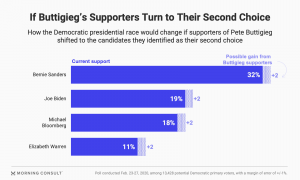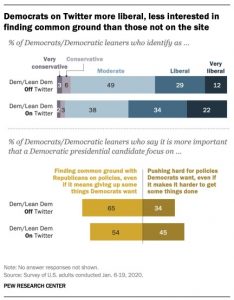On Wednesday, former Vice President Biden got a moving – and important – endorsement from Rep. Jim Clyburn, South Carolina’s most influential African American leader. Clyburn’s heartfelt testimony about his friendship, trust and love for Biden left many who were present for the event tearing up. It also showcased Biden’s greatest strength as a candidate, the ability to call Democrats to return to their identity as the party of compassion and connection to the disadvantaged. At U.S. News, Lisa Hagen makes the case that the “Clyburn Endorsement Has Value for Biden Beyond South Carolina,” and observes that “his large network of endorsements could end up being particularly useful if the nominating contest drags on until the national convention and party leaders – like Clyburn – play a pivotal role in helping to name the Democratic presidential nominee…If he can pull out a victory in South Carolina and, more importantly, a decisive one, Biden could convert that momentum to buoy him in many of the contests held on Super Tuesday, in which more than a third of the pledged delegates will be up for grabs. And if he can demonstrate his strength among African American voters, he has the potential to perform well in a number of Southern states holding contests on March 3 that also have large constituencies of black voters.”
Could Sen. Bernie Sanders take a page from FDR to add credibility to his campaign for the Democratic presidential nomination? Sophie Vaughan thinks so, and she explores the possibilities in “How Bernie Sanders Is Reviving the Promise of FDR’s Economic Bill of Rights: There are deep parallels between what Bernie Sanders is proposing and what Franklin Delano Roosevelt promised” at Common Dreams. As Vaughan writes, “Increasingly, Sanders surrogates on the campaign trail have framed the candidate’s ideas as an extension of the Economic Bill of Rights,” Vaughan writes, “a concept first proposed in 1944 by President Franklin Delano Roosevelt in his State of the Union address…The remaining Democratic candidates—Vice President Joe Biden, former New York City Mayor Michael Bloomberg, former South Bend, Indiana, Mayor Pete Buttigieg, Minnesota Senator Amy Klobuchar, and billionaire investor Tom Steyer—all oppose a Medicare for All plan. But many propose that those who can’t find private insurance should be able to qualify for expanded government insurance plans…None of these candidates, however, have placed their policies so explicitly in the lineage of Roosevelt’s Economic Bill of Rights as Sanders. While Sanders has not proposed a constitutional amendment for his economic rights as Roosevelt did, the point is already subject of debate among those who study Roosevelt.”
Vaughan continues, “We have come to a clear realization of the fact that true individual freedom cannot exist without economic security and independence,” Roosevelt said in the 1944 speech. “Necessitous men are not free.”…The Economic Bill of Rights never came to fruition because Roosevelt’s illness and eventual death prohibited him from pushing further for the amendments. With his campaign, Sanders has now taken on the mantle of this bill of rights…One of the proposals that Roosevelt outlined, “the right to adequate medical care and the opportunity to achieve and enjoy good health,” sounds similar to the hope expressed by many Sanders supporters at the community conversation…[FDR scholar Harvey] Kaye says Roosevelt was serious about the constitutional amendment, but some scholars, such as Harvard Law School Professor Cass Sunstein, argue that the President never planned to actually go through with pushing for this amendment. Sunstein says the rights were merely a framework to advocate economic rights be respected to the same extent as social rights.” One demographic reality that makes the strategy palatable, is that many high-turnout senior voters, remember well that their parents regarded FDR as a peerless visionary, whose inspiring courage in the face of many doubters, saved America from ruin. Strongly invoking a connection to FDR can’t hurt Sanders — and it might help.
But Sanders will also have to more persuasively address this concern, cited in E. J. Dionne, Jr.’s column, “Democrats are dealing with a generational divide” in The Washington Post: “In January, Gallup asked: “If your party nominated a generally well-qualified person for president who happened to be a socialist, would you vote for that person?”Among adults under 35 years old, 63 percent said yes. But only 42 percent of those aged 35-54 answered affirmatively, and just 35 percent of those over 55 said yes. Even among Democrats, 21 percent said they would not vote for a socialist; for independents, that figure was 51 percent…The S-word would thus be a heavy burden to carry into a tightly fought campaign, as a timely study by political scientists David Broockman and Joshua Kalla published Tuesday in Vox suggested…In analyzing an early-2020 40,000-person survey, they found that “nominating Sanders would drive many Americans who would otherwise vote for a moderate Democrat to vote for Trump.”…To offset these losses, Sanders “would need to boost turnout of young left-leaning voters enormously,” Broockman and Kalla wrote. They conclude: “There are good reasons to doubt that Sanders’s nomination would produce a youth turnout surge this large.”
In their article, “The Sanders Tax: How our Electoral College ratings might change if he becomes the presumptive nominee‘” Kyle Kondik and J. Miles Coleman write at Sabato’s Crystal Ball: “If Democrats nominated Bernie Sanders, they would, initially, start off with somewhat of a penalty in our Electoral College ratings…Sanders’ policy prescriptions and rhetoric may complicate Democratic prospects in the Sun Belt, where the party’s recent growth has been driven by highly-educated suburbanites…Given the composition of the 2020 Senate map, which features more Sun Belt states, Sanders’ relative strength in the Rust Belt — assuming that even ends up being the case — nonetheless doesn’t help Democrats much in the race for the Senate.”
With respect to Sanders’s prospects in the largest swing state, Kondik and Coleman write, “State analyst and mapper Mathew Isbell attributes the Democratic losses in Florida in 2018 to their underperformance in Miami-Dade County. In 2018, then-Sen. Bill Nelson (D-FL), and the Democrats’ gubernatorial nominee, then-Tallahassee Mayor Andrew Gillum, gained over Clinton elsewhere in the state, but they couldn’t match her showing in the Miami area. Instead of Clinton’s 29 percentage point margin there in 2016, Nelson and Gillum each carried it by a smaller 21 percentage point spread. Rather astoundingly, they each flipped four large Trump counties — St. Lucie, Pinellas (St. Petersburg), Seminole (Orlando suburbs), and Duval (Jacksonville) — but both came up short because of their weaker margins in Miami-Dade County. One-third of the county’s electorate is Cuban; Sanders’ comments praising some aspects of Fidel Castro’s regime could be uniquely toxic with this bloc, and may effectively push Florida out of reach.”
Kondik and Coleman continue: “Sanders is also a candidate whose strongest appeal is with the young, whereas Florida has an older electorate. According to the Census Bureau’s American Community Survey, Florida’s median age is 41.8 years, and only four states rank higher. Interestingly, other comparatively old states include Maine, New Hampshire, and Sanders’ home state of Vermont, but retirees who can afford to move to Sun Belt states like Florida have typically voted Republican — and perhaps more importantly, they turn out. In 2016, senior citizens powered Trump’s coalition in the Sunshine State. Over 80% of voters 65 and older turned out, and exit polling showed Trump winning this group in a 57%-40% vote. Voters under 30 favored Clinton, but turned out at just 56%; Sanders likely would inspire higher turnout with millennials, but the GOP’s dominance with seniors in Florida has proved to be a potent electoral force.”
Former South Bend Mayor Pete Buttigieg has taken his share of heat in the battle between the so-called “moderate” Democratic presidential candidates, and he is still standing. Buttigieg may have underestimated the intensity of the resentment he would encounter as a result of his comparative inexperience. As a former Mayor of the 4th largest city in Indiana, he has made the most of his ‘outsider’ status. But it’s a tough sale to close, when voters compare his governing record to that of his opponents. Yet, a fair-minded review of Buttigieg’s policies indicates that he is a solid progressive, and face it, he is the most articulate communicator of the lot. However, the 2020 campaign has revealed that he has work to do in broadening his credibility with African American, Latino and blue collar voters. His recently-deleted tweet which dissed Sanders’s “nostalgia for the the revolutionary politics of the ’60s” seemed to overlook that it was also a time when MLK’s leadership of the Civil Rights Movement transformed America (Sanders was an active member of the Congress of Racial Equality (CORE) and the Student Nonviolent Coordinating Committee (SNCC), who was arrested in a school desegregation protest in Chicago in 1963 and also participated in the March on Washington in that year). At 38, however, Buttigieg has plenty of time to build his resume and his cred with these key constituencies. It’s not hard to envision him as the front-runner in a future presidential campaign.
From Alexander Hertel-Fernandez, a Columbia University political scientist, interviewed by Mary Harris in “ALEC: How Republicans Use It to Gain Power” at slate.com: “When Republicans take over state governments, they first try to weaken unions and other progressive activist groups, and then change election rules in ways that will make it easier for them to win again…Many state legislatures don’t give lawmakers the proper resources to make policy. ALEC provides all of those resources: the ideas behind the bills, the polling that they would need to pass, a hotline that lawmakers can call if they want help drafting a piece of legislation or coming up with a good argument. ALEC essentially serves as a private research assistant for state legislators…There have been a number of progressive efforts over time to construct counterweights to ALEC, [the American Legislative Exchange Council] but they’ve often fizzled out because they haven’t received sufficient attention from donors or were too focused on organizing power in states that were already progressive, like New York or California. The State Innovation Exchange supports local legislators in a number of key states. Future Now is trying to replicate ALEC’s success by building a national network and thinking about the ways policy can be used to either advantage one’s allies or defang one’s opponents.”






